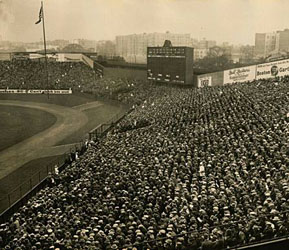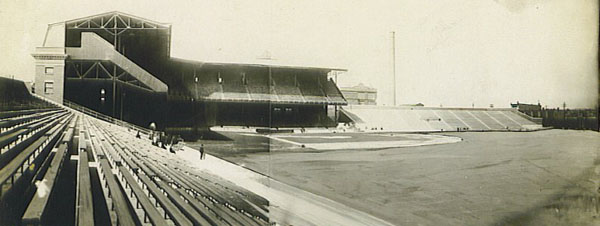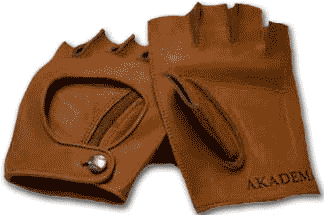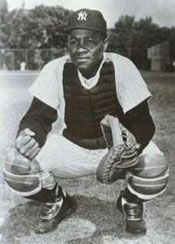|
|
Baseball
Firsts Archive – I
|
1870: Doug
Allison, catcher for the Cincinnati
Red Stockings, wore buckskin mittens to protect his
hands from fastballs. He is the earliest known player to use a glove
of some kind. About the same time, another catcher Frank
Flint, used a thin leather glove padded with beefsteak.
However, players who used any kind of glove were ridiculed by fans and
other players. A first baseman, Charlie Waitt, took
throws wearing an unpadded, fingerless glove with a hole in the back
for ventilation. The contraption was flesh-colored in an unsuccessful
attempt to conceal it.
In 1877, Albert
Spalding used a black glove while playing first base. As
a star player, Spalding could get away with the "sissy"
aid. Within a few years, just about everyone (except pitchers) wore
gloves of one kind or another. In the early 1880s, the first padded
glove appeared quickly followed by the prototype of the modern catcher's
mitt. Spalding founded a very successful sporting goods
company that has produced gloves for well over a century. (It is now
a division of Russell Corporation.) |
PA
Announcer
The first public address announcer worked at the Polo Grounds for the New
York Giants on July 5, 1929. In 1993, the
Giants, now in San Francisco,
scored another first when they made Sherry Davis the first
female PA announcer in MLB (and the first in any of the major American professional
sports leagues). Then in 2002, Renel Brooks-Moon, who replaced
Davis behind the mike when the club moved to Pac Bell Park
(now AT&T Park), became the first woman PA announcer for a World Series
game (and, in fact, the first to announce a championship game or series of
any professional sport).
Resin
Bag
The pitcher was allowed to use a resin bag for the first time in MLB in 1925.
With the introduction of a more lively ball and the banning of the spitball,
shine ball, and other doctored pitches in 1920, the resin bag was considered
an attempt at achieving more balance in the pitcher-hitter competition. Use
of resin would give pitchers a better grip on the ball. However, its use was
by no means universally approved and added to the tension between MLB Commissioner
Kennesaw Mountain Landis, who approved the measure, and AL
president Ban Johnson. The NL readily approved the measure,
but the AL did not for fear the resin bag would reopen the door to "freak"
pitches. The matter was referred to a joint Rules Committee, which approved
use of the bag by majority vote. The umpire was to carry a small bag of resin
which the pitcher could ask to use. However, living up to his name, Johnson
banned the resin bag in his league, promising to suspend anyone who used it.
Trying to forge a compromise that would not embarrass either of their bosses
(Landis and Johnson), the AL owners voted
to allow the umpires to carry a resin bag but asked all managers to instruct
their pitchers not to request it!
Pitching
Machine
The first pitching macine was demonstrated on December 15, 1896
by a Princeton University mathematics
professor named Charles E. Hinton. He built it after seeing
the college's pitchers get sore arms from pitching batting practice. After
trying a catapult, which had no accuracy, he assembled a cannon-like mechanism
that could be expanded or contracted to regulate the speed of the pitch. To
pitch, the user pulled the trigger on a rifle loaded with blanks. After much
trial and error, Hinton engineered his machine to throw curveballs.
However, when the Princeton
team tried the machine, the batters were nervous about being shot at. So Hinton
rigged the machine to allow the batter to trigger the pitch using a button
he depressed with his foot. On June 10, 1897, before a crowd that included
Mrs. Grover Cleveland, the machine pitched for both sides
in a three-inning intramural game at Princeton.
It struck out eight batters, walked one, and allowed four hits. The biggest
complaint was the long time required for reloading the machine after each
pitch. Hinton's invention was featured in Scientific
American. On August 13, 1900, it pitched to both sides in a Southern
Association game between the hometown Memphis
Chickasaws and the Nashville Volunteers.
The gun struck out two and allowed no runs in two innings. Unfortunately,
no teams wanted to buy the machine because of the fear it continued to instill
in the hitters. Hinton died in 1907 at age 54 without ever
seeing his invention in wide use.
Amateur
Draft
The first Amateur Draft was held in 1965. Prior to that year,
each club signed whatever amateur players it could get. The first player selected
in the 1965 draft was OF Rick Monday of
Arizona State University by the Kansas
City Athletics. Rick played 19 seasons with
the A's (in KC and Oakland),
Cubs, and Dodgers.
Other well-known players drafted in the first round included OF Billy
Conigliaro by the Red Sox,
C Ray Fosse by the Indians,
1B Jim Spencer by the Angels,
and 3B/OF Bernie Carbo by the Reds.
Uniform
Numbers
The New York Yankees were the first
team to permanently place numbers on their uniform shirts and the first to
do so on both their home and road uniforms. They did this starting with opening
day of the 1929 season. However, since the Yankee
opener was delayed by rain, the Cleveland Indians,
who were merely experimenting, actually wore uniform numbers in a game for
the first time. The Yankees assigned
numbers to players based on their position in the batting order. So #1 was
Earle Coombs, 2 Mark Koenig, 3 Babe
Ruth, 4 Lou Gehrig, 5 Bob Meusel,
6 Tony Lazzeri, 7 Leo Durocher, 8 Johnny
Grabowski. 9 was assigned to backup C Benny Bengough.
Number 10 was young C Bill Dickey. The remaining numbers
were given to the pitchers and utility players. To this day, it is almost
unheard of for a pitcher to wear a number less than 10. The Washington Senators
were the second team to regularly wear numbers on their back. Before the 1931
season, the American League voted to require all clubs to follow suit. However,
the National League held out, citing two reasons. (a) The numbers depersonalized
the players and (b) true fans recognized their favorites. However, the Senior
Circuit relented in the middle of the 1932 season.
Umpiring
Hall of Fame umpire Bill
Klem is credited with several firsts. (a) First
to wear a flexible "inside" chest protector. (b) First to use arm signals to indicate balls and strikes. His chest protector
replaced the outside "balloon" protector and allowed him to lean
closer over the catcher to call pitches. He also began looking through "the
slot" just over the catcher's shoulder nearer the hitter. He persuaded
the National League to mandate the inside protector for all its plate umpires.
The American League continued to use the balloon protector until 1977. Since
the balloon protector forced the ump to stand more straight up and look down
over the C's head, the AL became known for a higher strike zone than the NL.
Note: I have been unable to find a date for Klem's introduction
of the inside chest protector. Player Homering from Both Sides in a Game
The first player to hit a HR from both sides of the plate in a game was C
Wally Schang of the Philadelphia
A's on September 8, 1916, against the Yankees.
Eddie Murray holds the lifetime mark of 11. Mickey
Mantle did it 10 times. Ken Caminiti holds the MLB
record for a season with 4 in 1996 with the Padres.
Pinstripes
The first teams with pinstripes on their uniforms were the New
York Giants and the Philadelphia
Phillies in 1911. The Yankees
adopted their famous pinstripe design the next season, although they discarded
the stripes in 1913 and 1914. They resumed them in 1915 and have worn them
at home every season since.
Retired Number
The first Major League Baseball player to have his number retired was Lou
Gehrig (#4). The occasion was the famous July 4, 1939, doubleheader when he
gave his "Luckiest man on the face of the Earth" speech after
being struck with ALS. The first person to have his number retired by two teams
was Casey Stengel. The Yankees
and the Mets retired #37 to
honor his managerial careers with them (although his only distinction for
the Mets was that he was their
first skipper). For an extensive listing of retired numbers, click
here. The
first radio play-by-play of a major league game occurred on August
5, 1921 on KDKA in Pittsburgh. Harold Arlin, a
Westinghouse employee, used a telephone to report the play-by-play
of a game between the Philadelphia
Phillies and the Pittsburgh
Pirates to a special three-station hookup of KDKA,
WJZ in Newark NJ, and WBZ in East Springfield MA.
The first telecast of a World Series occurred in
October 1947. NBC televised the games between the New York Yankees and Brooklyn Dodgers to New York, Washington, Philadelphia and Schenectady. The announcers were Bill Slater, Bob Stanton and Bob Edge. Gillette and Ford sponsored the telecasts.
Electronic Scoreboard
The first baseball park to have an electronic scoreboard was Yankee Stadium in 1959. Previously, all scoreboards were hand-operated. |

Original Yankee Stadium scoreboard 1922 |
Steel/Concrete Stadium
The first entirely steel and concrete stadium was Shibe Park, home of the Philadelphia Athletics, in 1909. The park was named for Ben Shibe, 50% owner of the A's and partner in A. J. Reach & Company, manufacturers of baseball equipment. Baker Bowl, home of the Phillies only a few blocks away, had a concrete-and-steel grandstand but wooden bleachers. Forbes Field in Pittsburgh, another concrete/steel edifice, didn't open until eleven weeks after Shibe.
Personal note: While in Philadelphia in 2005, I walked from my hotel to the sites of Baker Bowl and Shibe Park. I had entered the street locations into MapQuest to determine the sites because today you'd never know a ballpark inhabited either location. The tenement houses behind RF of Shibe Park that caused a furor – like those outside Wrigley Field – by giving spectators a free view of the action, still stand.

Shibe Park when it opened in 1909
Team Statistician
The first full-time statistician hired by a major league club was Alan Roth in 1947 by the Brooklyn Dodgers. Roth, a native of Montreal who had worked as a statistician for the Canadiens of the National Hockey League, approached Branch Rickey, Dodger president, with a proposition. Wouldn't it help a manager if he knew that a certain batter hit .220 against right-handed pitchers and .300 against left-handers?
Intrigued, Rickey hired Roth, who charted every pitch and did the calculations in his head or with a simple calculator throughout his career. He often worked from the broadcast booth, feeding pertinent data to Dodger announcers. He moved with the Dodgers to Los Angeles in 1958 and remained with the club until 1964, when he left to work with NBC and then ABC on their broadcasts. |
Woman Owner
|
The first woman to own a major league team was Helene Britton of the St. Louis Cardinals from 1911 to 1917. She succeeded to the ownership when her uncle, Stanley Robison, died. He had in turn inherited the club from Helene's father Frank Robison upon his death in 1908. "Although she met resistance from most of the male owners, she proved to be a capable executive and oversaw the day-to-day operations of the club." (Baseball’s Most Wanted: The Top 10 Book of the National Pastime’s Outrageous Offenders, Lucky Bounces, and Other Oddities” by Floyd Conner)
|
|
|
Umpiring Staff
The first umpiring staff was assembled in 1879 by National League president William A. Hulbert. Teams could choose arbiters from a group of 20 men. Previously, the two captains agreed on an umpire, who invariably was from the local area. This created suspicions of bias in favor of the hosts and, in some cases, collusion with gamblers. The umpires, who were paid $5 a game starting in 1978, were also given authority to impose fines for misconduct.
Batting Doughnut
|
Elston Howard, long-time C for the Yankees, invented the batting doughnut, officially called "Elston Howard's On-Deck Bat Weight." The patent was issued in 1967, his 13th and second-to-last season as a ML player. The on-deck hitter places the metal ring around the barrel of the bat to add weight and make the bat feel lighter when he steps into the box. The first club to buy Howard's invention was the St. Louis Cardinals. The device quickly caught on and ended the habit of players swinging two and three bats in the on deck circle. Howard and his backers failed to make the expected windfall on their invention because the bat companies made their own, flooding the market. Howard and company didn't have the money to fight the patent infringement in court. |
The 1952 Brooklyn Dodgers were the first team to wear numerals on the front of the uniform. They did so only on the home uniform. |
|
|





